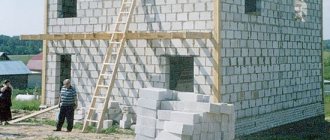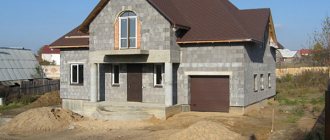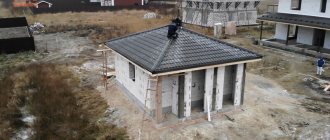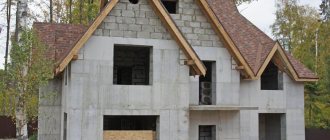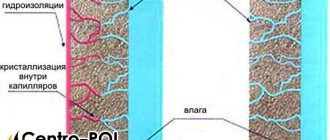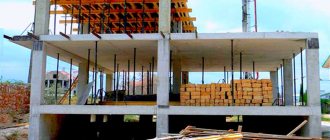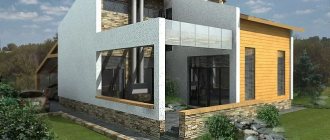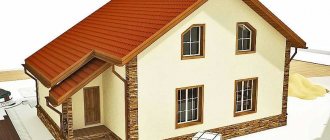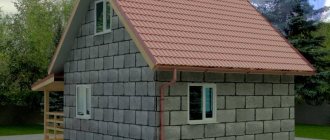When planning the construction of a private house, it is logical to weigh all the pros and cons, compare and contrast different options and construction technologies, as well as the use of building materials.
Among many organizational issues, you need to decide what is best to build a house from. The topic is broad and multifaceted, each material has advantages and disadvantages, but specifically in this case, wall material made of cellular concrete - foam concrete - will be considered.
We recommend that you read the article on the topic: the pros and cons of foam concrete blocks
Pros and cons of foam concrete houses
Pros of a foam block house
Low thermal conductivity
Cellular concrete materials (foam concrete, aerated concrete) have a unique porous structure, making them good heat insulators.
Light weight
Depending on what brand of foam concrete blocks are used, the weight is 1 cubic meter. ranges from 300 to 1200 kg. This leads to more lenient requirements for the foundation and, in practice, results in the opportunity to save on materials for the foundation of a foam block house.
Minimum hygroscopicity
In the process of producing foam concrete, a method is used to form blocks by pouring them into molds. This affects the geometry of the block, but promotes the formation of closed pores. It is thanks to this that foam concrete does not absorb moisture from the environment. A simple test, immersing foam concrete in a container of water, can demonstrate the block's resistance to water absorption.
Durability of foam concrete
This is due to the fact that concrete, which forms the basis of foam concrete, gains strength during operation. That is, the longer the house stands, the stronger the foam concrete will be.
Resistance of foam concrete to fire
In terms of fire safety class, foam concrete is one of the safest building materials, since it does not burn and does not support combustion.
Environmental friendliness of foam concrete
To make foam blocks, water, sand, cement and foaming agents are used. The latter can be of two types: natural and synthetic. Even if synthetic foaming agents are used, their specific gravity is no more than 0.5% of the total mass, which allows us to confidently declare the environmental friendliness of the material.
High speed of construction of a house from foam blocks
Installing one block is faster than laying bricks of the same square footage. Plus, the installation error will be significantly lower.
The ability to implement any architectural style
Foam concrete is easy to process. Cutting, drilling, and grinding the block is not difficult and does not require the use of special tools. Thanks to this, even a beginner with no experience in construction can remove the box of a foam block house.
Convenience of laying communications in foam concrete
Dictated by the flexibility of the blocks for processing, they are easy to groove for laying pipes, wiring, etc.
No finishing requirements
A house made of foam concrete can be used for a long time without additional finishing. As a rule, cladding is performed purely for aesthetic reasons. The most popular option is decorative plaster. A foam concrete house can be finished with any of the existing materials; it is important that they are designed for foam concrete blocks and do not have a negative impact on the microclimate in the building. Otherwise, the house’s ability to “breathe,” which is due to its porous structure, may deteriorate.
Easy to decorate
Thanks to its smooth surface, foam concrete can be plastered or finished with any other finishing material with minimal effort in preparation for finishing.
Relatively low price of foam block
Despite the fact that in absolute terms, foam concrete (35-39 rubles/piece) costs more than brick (6-10 rubles/piece). But to cover the same area, you will need one foam block (35-39 rubles/piece) and 13.5 bricks (13*6=78 rubles). The benefit is obvious. And taking into account the fact that the house does not need insulation and a strong foundation, savings can reach up to 30%.
Low cost of laying foam blocks
This aspect is relevant for those who do not plan to build a house from foam blocks with their own hands.
Useful tips
Knowledge of the features of this popular material will allow you to build a house or erect partitions without hassle. Basic Rules:
Buy foam blocks from trusted manufacturers. Pay attention to the clarity of the lines. Correct geometry is the key to quick and high-quality masonry.
If you find high-quality material with a smooth surface, buy special glue for foam blocks. Working with adhesive composition requires skill and highly qualified builders. The minimum thickness of the seam and the absence of irregularities will allow you to create monolithic masonry.
If you do not have sufficient experience in construction work and the quality of the foam blocks is average, use a good quality cement-sand mixture from well-known manufacturers. Achieve a seam thickness of up to 3 mm. A thick layer of glue or cement-sand mixture reduces the sound and heat insulation properties of foam concrete blocks.
Disadvantages of a foam block house
House shrinkage
A house made of foam concrete shrinks by 2-3 mm per linear meter; finishing can only begin after a certain period of time (at least six months). Shrinkage is caused by a long-term reaction between the constituent components of the foam concrete solution.
Foam concrete has a porous structure
The advantage of porosity is that it gives the foam block low thermal conductivity, but complicates the process of installing fasteners into the wall. The solution is to use special fasteners designed for foam concrete. Their price is practically no different from the cost of conventional fasteners.
Requirements for finishing material
Only special plasters and paints are used for wall decoration.
The need for foam concrete reinforcement
The reinforcement is laid in the area of the openings, and every 4-5 row of blocks is also reinforced. Without the appropriate armored belt, it is not possible to reliably install the floors and rafter system.
There is a high probability of purchasing a counterfeit
The fact is that the raw materials and equipment for the production of foam concrete are relatively cheap, so blocks are often made in an artisanal way, which is fraught with violations in production technology and affects the quality of the product.
Direct relationship between the strength/thermal insulation properties of a material
With increasing strength (structural grades D 1000-1200), the thermal conductivity of the material increases. Conversely, insulating foam block (grade D 300-500) cannot be used as a material for the construction of load-bearing walls. Especially when it comes to multi-story construction.
The fragility of the foam block
On the one hand, it provides simple processing of the block, on the other hand, the load-bearing capacity of the material is reduced.
Requirements for calculating the load on foam concrete
The need for careful calculations of the thickness of walls and partitions, taking into account all possible loads. Usually walls are built with a safety margin.
Unaesthetic appearance of a foam block house
A house built from cellular concrete is often finished precisely in order to eliminate this drawback.
The need for a form-building foundation
Those. such a foundation for a house made of foam concrete blocks, which will help level out the low flexural strength characteristic of foam concrete.
Not ideal foam block geometry
This means that each block needs to be sanded before laying, which slightly increases construction time.
As you can see, a house made of foam concrete has both pros and cons. Therefore, it is difficult to give an unambiguous answer as to what characteristics a house built from cellular concrete blocks will have. It all depends on the quality of the material itself, the skill of the mason, and adherence to the foam block laying technology. The master must reduce the negative aspects of a house made of foam blocks to a minimum and not ruin the advantages that the use of foam concrete imparts to the house.
Aesthetic qualities
If we talk about aesthetics, it is unlikely that anyone likes the appearance of the foam block. Any other material will attract more attention from both builders and ordinary people. On top of everything else, foam block limits your creative freedom: more often we see standard houses made of this material than beautiful cottages. The selection of colors is very small and will disappoint you if you like bright colors. Although, if desired, you can solve the problem with the help of finishing, such a building will still not be able to compare with a building made of a similar material, for example, wood.
House made of foam blocks - reviews from owners
Manufacturers of foam concrete and craftsmen who lay blocks unanimously claim that foam concrete is an ideal solution for individual construction. Foam blocks, large and at the same time light, allow you to build a wall in record time, and the porous structure makes it unnecessary to insulate a house made of foam concrete.
Is this really so or are the manufacturers hiding something from us?
You can impartially judge which foam concrete house is based on the reviews of those who already live in it. The opinions of real users differ; some consider foam concrete an ideal solution, others are categorically against it.
When deciding whether to build a house from foam blocks, reviews from the owners will come in handy.
Victor (Moscow region)
I offer my know-how. Maybe someone knows this trick, but I figured it out myself. I was going to build a house with my own hands. I have some experience and assistants too. I read a lot of reviews about foam concrete. They write in different ways. But, in the village, half of the houses are foam concrete. So I settled on it.
One thing that confused me was that if the screws don’t stay in the block, how to install the doors and windows? They fall out.
The decision came unexpectedly. The blocks intended for laying the outer wall were sawn worse than the blocks of the inner row, due to their greater density. So we decided to install denser blocks along the contour. So what if their thermal conductivity is lower, there will still be plaster inside. Everything is holding up great. And in order to really hang shelves, you have to keep a supply of special dowels.
As an experienced builder, I note that it is necessary to strengthen openings, even arched ones, in any house, with metal corners. For clarity, here are a few photos.
Strengthening openings with corners
Strengthening foam concrete openings with a corner
Strengthening foam block openings with a corner
Strengthening a foam concrete opening with a corner
Stepan (Tula region)
Why did we decide to build a house from foam concrete?
- The savings became noticeable even at the stage of pouring the foundation.
- The blocks were produced near the site - they were delivered free of charge. We have a suburban plot in the village of Malaya Dubna (Orekhovo-Zuevsky district, Moscow region) next to the manufacturer Penoblok.Ru.
- The geometry of the foam blocks is decent. We used special glue. At first glance, they overpaid, but the seams are thin, beautiful, and tight.
- The walls grew “by leaps and bounds”; we did not expect such a speed.
- The windows were installed immediately upon completion of the work.
We were frightened by the shrinkage of the house, but either the metal corners did their job, or the foundation did not let us down, or the house settled evenly, but no cracks appeared. True, it doesn’t look very presentable, but we haven’t gotten to the exterior decoration yet. In general, after 4 years of operation, there are no complaints.
Saburov brothers
We built a house made of foam concrete in the Rostov region. Summer here is warm but rainy, so over time we are going to cover the house with plaster. For now, to prevent it from picking up moisture, they covered it with a water-repellent agent. I asked the construction company and they recommended Antipluviol S Mapei. Expensive, in Rostov we have 5,200 for 5 liters.
I bought Ceresit ST 13 (2,150 for 10 liters). The walls don't darken, which means they don't draw water. The cracks have not increased over the 7 years of residence. And those that exist are clearly caused by the shrinkage of the foundation; the house did not stand up properly, they were in a hurry to build walls. As I understand it, the foam block, despite being lightweight, requires a good foundation. It's a pity that it came late. But finishing will improve the situation.
Nikita (Samara)
Before construction began, I read about the porosity of the foam block and that the fasteners do not hold well. Everyone advises using special fasteners. I thought this problem wasn’t worth a damn. It turned out to be in vain. How it came to interior work - at least shoot yourself.
While the water heater was hung up, they came up with so many devices so that it would stay in the wall and not fall on its head. Special dowels do not hold the heavy structure. We ordered furniture for the kitchen without any hanging units at all, only pencil cases and base cabinets. And it seems like this, small things, fasteners. Both the foam blocks are from the manufacturer and the construction technology is followed, but they are not insured against fragility in the walls.
Mikhail (Leningrad region)
I have been living in a foam concrete house for almost 12 years. Like any material, foam concrete has its disadvantages. For example, here and there there are cracks in the block itself, and there are a couple of cracked seams. But they are not critical and are probably caused by the fact that they used a mesh with a wire diameter of 2 mm for reinforcement, but it was necessary to take reinforcement of at least 6-8 mm. At that time, I didn’t want to bother with scoring the block, now we’re paying the price. But the house is warm, compared to our neighbors who live in insulated brick houses, ours, even not plastered, simply retains heat perfectly.
By the way, the walls are built in two rows. The first is made from a load-bearing (I don’t know the correct name) foam block of the D 800 brand, the second is from a thermal insulating D 400. And yes, the dowels hold in it perfectly, the main thing is to take it longer so that they can reach the second layer. In general, there are no complaints about the foam block house. The main thing is not to be lazy and study the technology both for those who build it themselves and for those who order the work (so that they can control it). And of course, follow it during the construction process.
Sergey Mikhailovich (Karelia)
What can you think, put your hand on the foam block and brick. Foam concrete is much warmer. A clear demonstration of savings on insulation. Of course, the best option would be wood; after all, the microclimate in the house is unique. But a rounded log or timber is more expensive, and it is not so easy to build a log house with your own hands.
So, from the point of view of microclimate and insulation, foam concrete is an ideal option. And complaints about cracks - so you need to stick to the installation technology or hire normal craftsmen. Otherwise they save on everything and then complain. It’s not for nothing that they say “the joy of a low price lasts less than the disappointment of poor quality.”
A house is not an object on which you need to save. It is better to do the finishing gradually, and the frame and foundation should be as required by the technology. And even better with a margin of safety.
Mikhail (Tula region)
I chose foam concrete to build a temporary hut at the dacha rather for reasons of economy. As a basis, a shallow strip foundation (the soil allows). The main purpose is to store garden tools, hide from the rain, and a place for a snack.
Nowadays the dacha plots are gradually being settled in, so we are thinking about building a permanent house. Based on the fact that there are no complaints about the temporary structure: the foam concrete has not cracked during this time, no cracks have appeared in the masonry, I will use foam concrete.
Types of foam concrete
Type of foam concrete and aerated concrete
There are several types of material. The classification is based on the manufacturing technology and the aggregate used.
- Expanded clay blocks. Natural and environmentally friendly. In production, materials such as cement, sand, water and clay are used, baked using a special technology and thereby obtaining increased thermal insulation characteristics. Compared to other types of foam concrete, expanded clay blocks have the highest thermal conductivity, that is, low performance in terms of thermal protection of the building.
- Foam concrete. During production, a special chemical reagent is used, which forms foam upon contact with water. Hardening of such products occurs under natural conditions.
- Aerated concrete. In addition to cement, sand and water, the composition contains lime and aluminum powder. It is these components that trigger the reaction to form pores. To gain strength, conditions are required that provide an increase in temperature, humidity and pressure. To meet these requirements, the process of strengthening takes place in special chambers - autoclaves.
Technology of laying foam concrete blocks
By the time the construction of foam concrete walls begins, a foundation must be built. The first mandatory action should be the creation of a water barrier between the base of the building and the future wall. To do this, the contacting surface of the foundation is generously covered with a coating containing bitumen, after which several layers of roofing felt are laid. Only after creating a reliable waterproofing barrier is the masonry of walls made of foam blocks, which includes several technological processes.
First row
The foundation surface is rarely ideal, differing in horizontal projection by 1-3 cm, and sometimes more. The task of the foam blocks laid in the first row is to create a surface that is as horizontally level as possible, allowing subsequent laying of building materials with a minimum of seams using polymer-cement glue.
Before installing corner blocks, you need to determine the degree of deviation of the foundation surface from the horizontal, for which a water level or a laser level is used. A cement-sand mortar is prepared, which can be used to adjust the thickness of the seam. The greater the difference between different sections relative to the horizontal plane, the thicker the solution becomes.
The block is placed first at the highest corner of the foundation, and the smallest possible masonry joint is formed. Using control of the horizontal level, the remaining corner elements of the masonry are then laid. As a result, the surface of the foam blocks laid in the corners should correspond as much as possible to one horizontal line, while the blocks themselves must be leveled in all projections.
After making sure that the corners are positioned correctly, cords are stretched between them, which serve as a guide when laying the order. Vertical seams, even when forming the first row, are closed with glue, so it is necessary that the master has both solutions and the appropriate tool at hand.
Second and subsequent rows
In the future, during construction, only assembly adhesive is used. For better adhesion (gluing) of foam concrete surfaces, they must be cleaned of dust as much as possible and coated with a thin layer of mortar. Only after this is glue applied, a uniform layer is formed using a comb and the masonry elements are pressed. Masonry adhesive is very flexible, so excessive force is not recommended. The blocks are gradually seated to the required level by lightly tapping with a rubber hammer.
Another feature of the adhesive mounting solution is the long initial setting time (1-3 hours depending on the humidity of the material, the consistency of the glue and the air temperature), so the blocks are laid in one row around the perimeter. The next row of blocks is placed after the glue in the previous seam has set.
When forming seams, some of the glue comes to the surface. The solution should be removed immediately with a spatula. If the glue is not cleaned off very carefully, by the time the next row is laid, the solution dries out and forms unevenness on the masonry surface, preventing the formation of a thin horizontal seam. To remove glue tubercles, you should have a special board with an attached abrasive on hand.
If necessary, cut off a fragment of a block, use a special hacksaw and a square. The latter allows you to create a cut surface geometry similar to the factory one. If problems arise with the evenness of the cut, it is more advisable to direct the cut edge towards the openings (here small unevenness is not a problem, and besides, they can always be straightened upon completion of the masonry).
Wall thickness is a trick question
In your search for what thickness to choose for a wall made of foam blocks, you may come across many different arguments and judgments, most of which will turn out to be unreliable information.
To protect yourself and find the right solution, we will describe several features that you should consider:
First, it is important to understand how low the temperature drops in winter. In areas where winters are very harsh, thicker walls with additional thermal insulation are certainly required.
Secondly, decide on the insulation - will you install it or make do with regular plaster?
For example, for houses where the thickness of the foam block wall is 300 mm, it is better to add thermal insulation material 50-100 mm thick.
Thirdly, insulation not only acts as a material that retains heat, but it also prevents the foam block from being exposed to ultraviolet rays.
Is it possible to build private one-story and two-story cottages in winter?
The optimal conditions for laying block walls are a warm, dry season at an air temperature of 5-35 degrees . It is not recommended to build in winter due to moisture and freezing of the blocks.
As a last resort, installation at temperatures down to minus 5-6 degrees is allowed, but provided that special, frost-resistant glue is used.
Special requirements are put forward for the storage of material. Foam blocks can be used with a residual humidity of no more than 25%. To ensure this, it must be stored indoors or under cover. The masonry area should also be protected from precipitation.
What is a foam block
Foam blocks are a material that is gradually replacing cauldrons, bricks and other natural or artificial stones. Ideally smooth edges, low weight, as well as the ability to produce foam blocks yourself make this material attractive.
To produce foam blocks, foamed concrete mortar is used, which is poured into special collapsible molds.
To obtain a cellular structure, gypsum, lime and, in some cases, aluminum powder are added to the solution. After pouring the solution into the molds, they are left alone until completely hardened. If necessary, finished foam blocks are trimmed and given a perfectly even outline.
Quite often, foam block is confused with gas block, although they have completely different production technologies and are united only by the fact that they both belong to the group of cellular materials.
Return to content
Material requirements
To build a shed, you need to choose materials manufactured at the factory. Since the production process is simple, they are often stamped in artisanal conditions.
You should not use such material, as it will allow moisture to pass through, will not be able to retain heat inside, and will quickly crack. As a result, the building will collapse in 2-3 years.
It is recommended to build the barn from D600 foam blocks. They have optimal strength class B2.5, which corresponds to the M-35 concrete grade.
The building will not freeze or collapse in the cold season, thanks to the following properties:
- The thermal conductivity of the blocks is low (the coefficient is 0.13-0.14).
- Frost resistance is moderate (coefficient F15-F35).
The blocks are not very heavy, so you can cope with the task on your own, or hire a small team.
Calculation of quantity and price
To determine the construction volume of foam blocks, you will need to know the perimeter of the house in plan and its height, the dimensions of the block and the area of window and door blocks. Calculations are made using area formulas .
For example, for a one-story residential building with a plan of 10x10 meters and D1000 foam blocks with dimensions of 600x400x300 mm, the required volume of blocks will be equal to:
- Weight of 1 m3 of material, 1000 kg/m3.
- Building perimeter: 10×2+10×2=40 m.
- The height of the walls at the corners is 300 cm.
- Laying in half a block = block length.
- The thickness of the glue solution is 2 mm.
- Price for 1 m3 of foam blocks, 4970 rubles.
- Window and door area.
- The height of the window opening is 135 cm.
- Window opening width, 105 cm.
- Windows 6 pcs.
- Doorway height, 200 cm.
- Doorway width, 90 cm.
- Number of doors, 2 pcs.
- The total area of the masonry is 120 - 8.505-3.6 = 107.89 m2.
- Wall thickness, 400 mm.
- Number of blocks, 567 pcs.
- The total weight of the blocks is 40828.8 kg.
- The total volume of blocks is 40.83 m3.
- Number of blocks per cube, 13.9 pcs./m3.
- Total cost of blocks, 202919.16 rubles.
- The cost of dry glue for the entire masonry is 1469.84 rubles.
The cost of laying foam concrete depends on the total volume of construction work, the complex configuration of wall structures, the presence of arched structures and the construction area. The average price range is 1200-1500 rubles. per 1 m3 , despite the fact that in Moscow the upper limit reaches 2500 rubles/m3, in St. Petersburg - 2000 rubles/m3, and in Voronezh - 1800 rubles/m3.
Read more about calculating prices and the number of blocks in this article.
